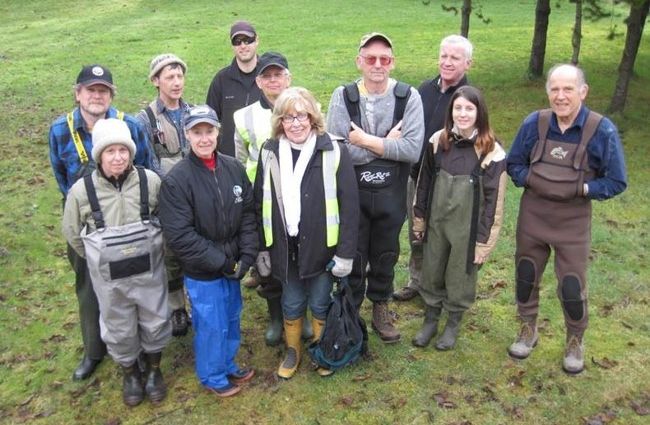“By sharing the story of Shelly Creek, we want readers to recognize that erosion is a common issue impacting salmon and trout habitats in small streams, draining into the Salish Sea,” stated Peter Law, Vice-President of the Mid Vancouver Habitat Enhancement Society
Note to Reader:
In 1999 the Englishman River on the east coast of Vancouver Island was declared an endangered river. Extinction of the salmon resource was viewed as a very real possibility. This catalyst for action resulted in two transformational outcomes: implementation of the Englishman River Watershed Recovery Plan (2001); and creation of the Mid Vancouver Island Habitat Enhancement Society (MVIHES).
Fast forward to the present. Shelly Creek, a tributary of the Englishman River that flows through the City of Parksville, is important to salmonids. MVIHES has established a provincial precedent with the Shelly Creek Water Balance & Sediment Reduction Plan; and this will have reverberations as the “Shelly Creek story” becomes well-known.
The Shelly Creek experience foreshadows that an informed stream stewardship sector may prove to be a difference-maker that accelerates implementation of the ‘whole-system, water balance’ approach in British Columbia.
MVIHES – Stewards of the Watershed
Over the past two decades, the evolving role of stream steward groups in British Columbia is exemplified by Englishman River experience. In the1990s, the ‘Coho salmon crisis’ raised the alarm and galvanized action to tackle the impact of human activities on stream health and fish survival in urbanizing watersheds.
Across Vancouver Island and the Lower Mainland, salmon enhancement stewardship groups formed. Many volunteer groups had their beginnings in small stream salmon enhancement projects.
Look Beyond the Creek Channel
A generation later, most community-based groups still exist. They provide thousands of volunteer hours to restore aquatic habitats. From (salmon egg) incubation boxes to habitat restoration, they partner with fisheries agencies to restore salmonid populations. Now the scope of stewardship sector involvement and influence is expanding beyond the creek channel.
 “Over time, MVIHES has morphed from Stewards of the Plan to Stewards of the Watershed. Beginning in 2011, the MVIHES action plan has concentrated on Shelly Creek. One of five Englishman River tributaries, it is the last fish-bearing creek flowing through the City of Parksville,” states Peter Law, MVIHES Vice-President & Director, Partnership for Water Sustainability in BC.
“Over time, MVIHES has morphed from Stewards of the Plan to Stewards of the Watershed. Beginning in 2011, the MVIHES action plan has concentrated on Shelly Creek. One of five Englishman River tributaries, it is the last fish-bearing creek flowing through the City of Parksville,” states Peter Law, MVIHES Vice-President & Director, Partnership for Water Sustainability in BC.
What the Community Watershed Monitoring Network has revealed
Erosion is the Issue
“Shelly Creek turbidity measurements were two times higher than the value established for acceptable sediment runoff in the Englishman River,” reports Peter Law.
“In fact, Shelly Creek’s turbidity numbers were the highest in the region (as reported in 2013). This was the alarm bell that alerted us to a serious problem with watershed health. By 2014, efforts to identify sediment sources and their causes, and then develop solutions, were underway.
”MVIHES secured funding from multiple agencies, in particular the Pacific Salmon Foundation, and developed the Shelly Creek Water Balance & Sediment Reduction Plan. Now, the challenge for MVIHES is to facilitate the community’s journey from awareness to action, expressed as follows:
Once a community as a whole acknowledges that there is a problem, and also understands why there is a problem, what will the community do about it?
 “By sharing the story of Shelly Creek, we want readers to recognize that erosion is a common issue impacting salmon and trout habitats in small streams, draining into the Salish Sea,” states Peter Law.
“By sharing the story of Shelly Creek, we want readers to recognize that erosion is a common issue impacting salmon and trout habitats in small streams, draining into the Salish Sea,” states Peter Law.
“Existing standards of practice have resulted in negative impacts. Continuing to use those standards will result in further environmental degradation of the watershed and loss of stream productivity.
“Building support for action starts with community engagement. Over the coming year, we hope to engage property owners along the stream at kitchen table discussions about what is happening, and focus on possible in-stream and off-stream solutions.
“They are seeing the impacts now, and will suffer in the future. It will require a bottom-up approach to inform, educate and inspire City and Regional District governments to implement 21st century policies for rainwater and development.”
A Funder’s Perspective
In addition to the Pacific Salmon Foundation, four other organizations provided funding, namely: MVIHES, Regional District of Nanaimo, City of Parksville and the Partnership for Water Sustainability.
 “As a co-funder, the Partnership is thrilled to have contributed to the Shelly Creek Plan,” stated Kim Stephens, Executive Director, Partnership for Water Sustainability in BC.
“As a co-funder, the Partnership is thrilled to have contributed to the Shelly Creek Plan,” stated Kim Stephens, Executive Director, Partnership for Water Sustainability in BC.
“We all learn from stories and the most compelling ones are based on the experiences of the champions who are leading by example in their communities.
Engage the Community
All of us have an impact on the land, on the water, and on the way things look. Restoring watershed hydrology and aquatic habitat depends on all the players embracing shared responsibility. There are solutions to be found if we communicate, cooperate, coordinate and collaborate. Commitment to action must be inter-generational. The Shelly Creek Water Balance & Sediment Reduction Plan is a starting point for ‘getting it right’.
Shared and Inter-Generational Responsibility
“MVIHES is a small group of community volunteers with limited resources. So the challenge is daunting. Yet someone has to spark a consensus in our community that: we must implement ‘state-of-the-art’ Rainwater Management practices ASAP, or we will lose what remains of fish values in Shelly Creek,” states Peter Law.
“The goal of restoring a healthy watershed with viable fish-bearing flows and habitats would take at least 50 years. Over the coming months, MVIHES will meet with owners of large land holdings about projects that could be implemented in the stream channel. Because stream channel restoration is costly and time consuming, our message will be that effectiveness depends on preventing erosion.
“We had better get busy,” concludes Peter Law.
Table of Contents
The table is a synopsis. It distills the essence of each section into a succinct statement. These create a storyline. Readers are asked to pause and reflect on them before reading the story itself.
To Download a Copy: https://waterbucket.ca/rm/files/2017/10/Shelly-Creek-Water-Balance-Demonstration_Oct2017.pdf




